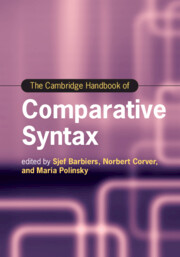Metrics
Full text views
Full text views help Loading metrics...
Loading metrics...
* Views captured on Cambridge Core between #date#. This data will be updated every 24 hours.
Usage data cannot currently be displayed.

Bringing together a globally representative team of scholars, this Handbook provides a comprehensive overview of comparative syntax, the study of universal and variable properties of the structure of building blocks in natural language. Divided into four thematic parts, it covers the various theoretical and methodological approaches to syntactic variation; explores dependency relations and dependency marking; shows how the building blocks of syntax both vary and display universal properties across languages, and explores the interfaces between syntax and other aspects of language structure. It also includes examples from a typologically broad range of languages, as well as data from child language, sign language, language processing, and diachronic syntax, giving a clear picture of the ubiquity of cross-linguistic variation. It serves as a source of inspiration for future research, and forges a deeper understanding of the variant and invariant parts of language, making it essential reading for researchers and students in linguistics.
 Loading metrics...
Loading metrics...
* Views captured on Cambridge Core between #date#. This data will be updated every 24 hours.
Usage data cannot currently be displayed.
This section outlines the accessibility features of this content - including support for screen readers, full keyboard navigation and high-contrast display options. This may not be relevant for you.
Accessibility compliance for the PDF of this book is currently unknown and may be updated in the future.